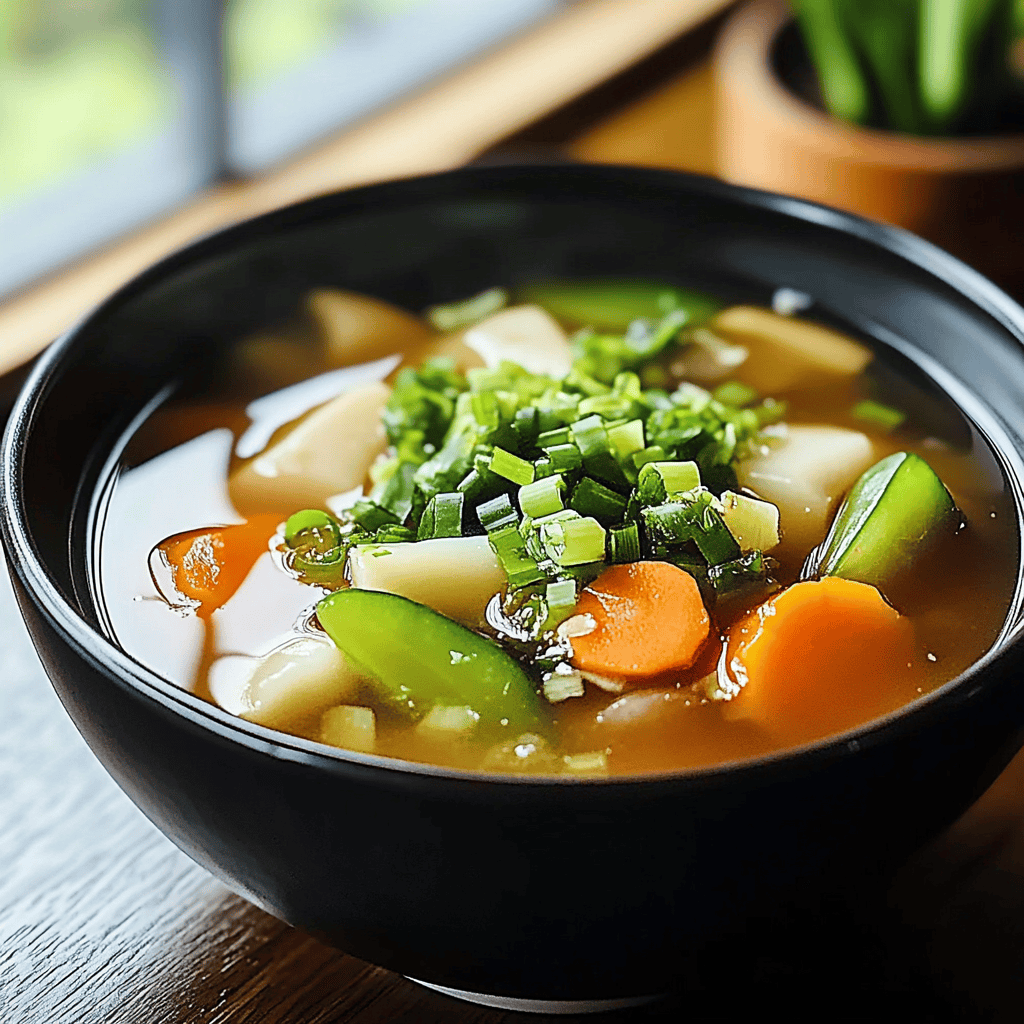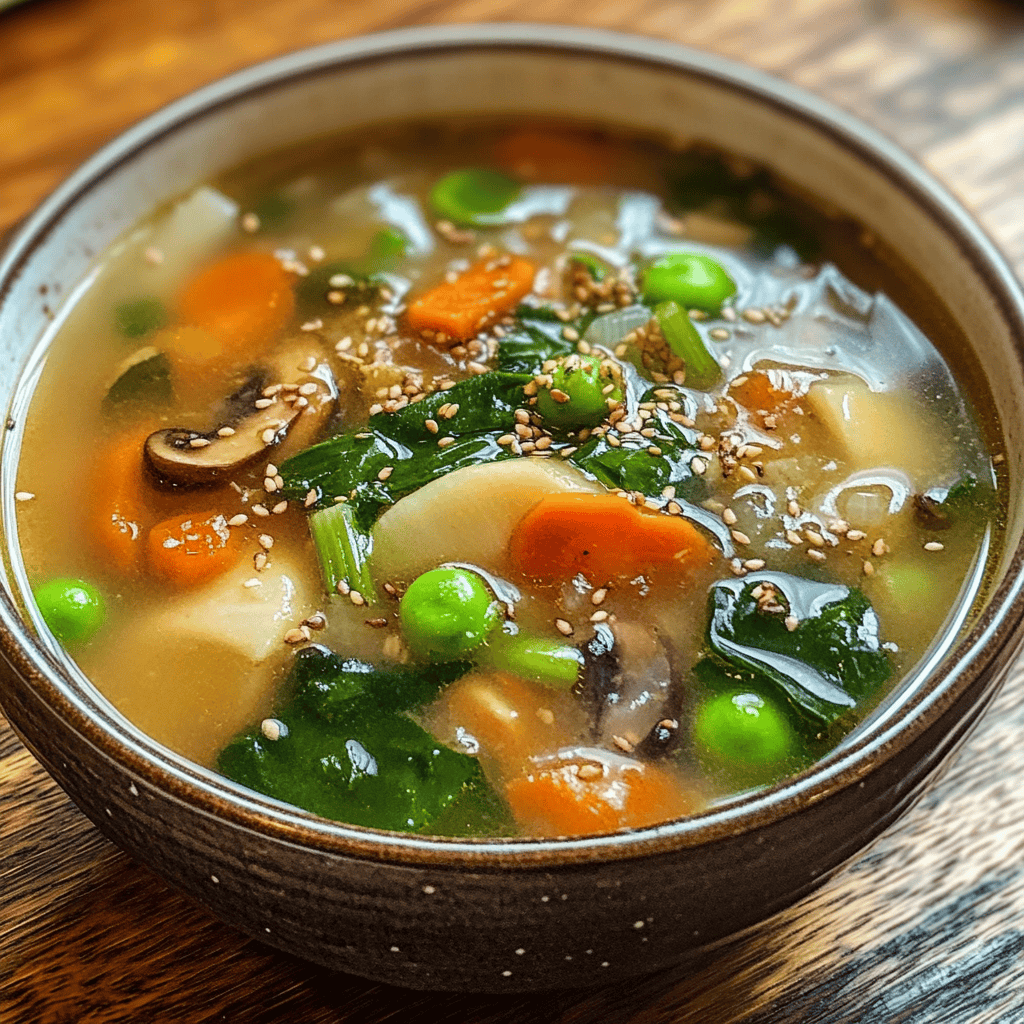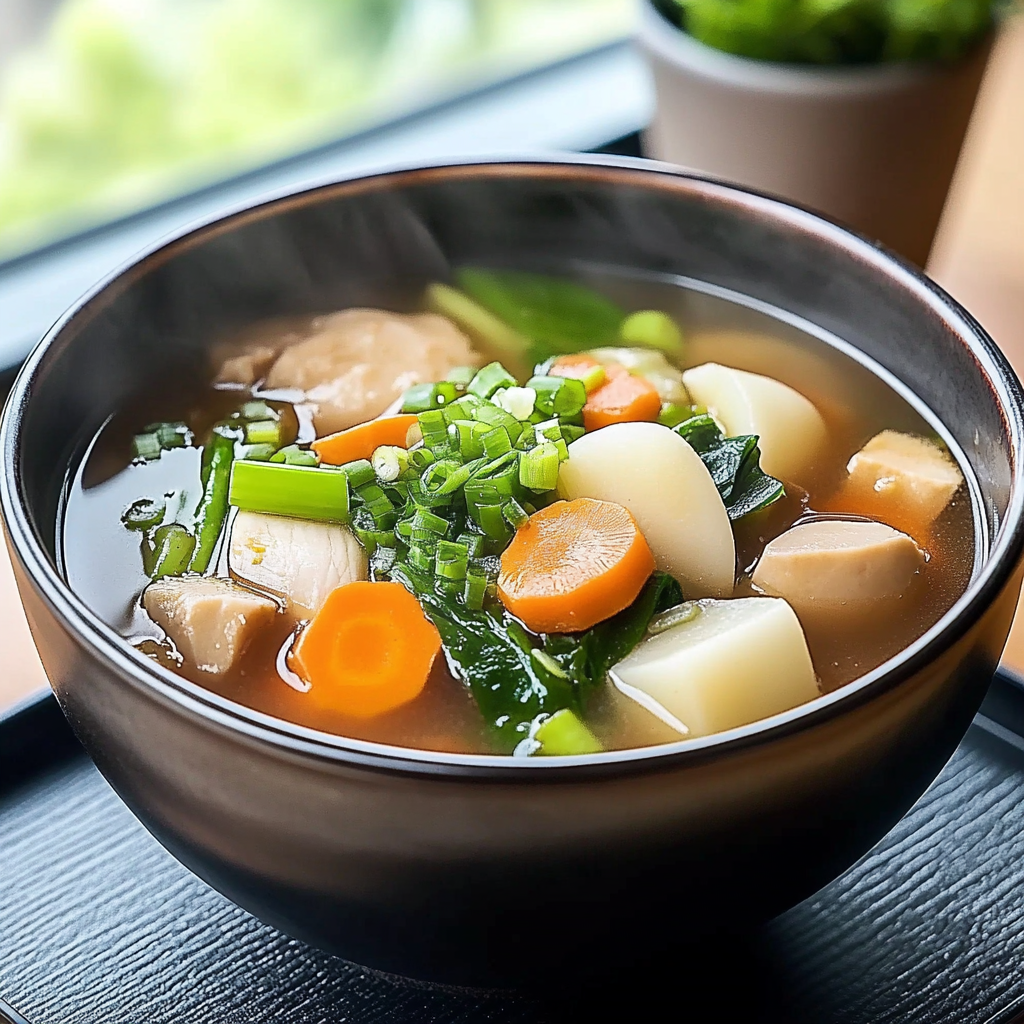Quick Overview
Japanese Veggie Soup is the perfect dish to warm up on chilly days while providing a burst of flavor and nutrition. This comforting soup combines fresh vegetables with umami-rich broth, creating a delightful experience for your taste buds. Whether you are seeking a light lunch or a wholesome dinner option, this recipe brings together the essence of traditional Japanese cooking in an easy-to-make format.
The beauty of this Japanese Veggie Soup lies in its versatility; you can adjust the ingredients based on what you have on hand or your personal preferences. With vibrant colors and textures, every bowl is as pleasing to the eyes as it is to the palate. Packed with vitamins and minerals from seasonal veggies, this soup not only nourishes but also boosts your immune system.
In just a few simple steps, you can whip up this delightful dish that will impress family and friends alike. Follow along as we break down the ingredients and guide you through each step to create this warming delight in no time.
Ingredient Breakdown
1. **Vegetable Broth (4 cups)**
A flavorful base that enhances the taste of the soup while providing essential nutrients. Choose low-sodium options for a healthier dish.
2. **Carrots (2 medium)**
Chopped into thin rounds, carrots add natural sweetness to the soup and are rich in beta-carotene.
3. **Shiitake Mushrooms (1 cup)**
These mushrooms bring an earthy flavor along with a chewy texture that complements other ingredients beautifully.
4. **Zucchini (1 medium)**
Sliced into half-moons, zucchini adds freshness and crunch while being low in calories.
5. **Green Onions (2 stalks)**
Chopped finely, green onions enhance the flavor profile with their mild onion taste and vibrant green color.
6. **Soy Sauce (2 tablespoons)**
Adds depth of flavor with its salty and savory notes; opt for gluten-free soy sauce if needed.
7. **Miso Paste (2 tablespoons)**
This fermented soybean paste contributes richness and umami flavor; white miso works best for a milder taste.
8. **Tofu (1 cup)**
Cubed firm tofu provides protein while absorbing flavors from the broth.
9. **Spinach (2 cups)**
Fresh spinach wilts down quickly in the hot broth, adding nutrients without overpowering the other flavors.
10. **Sesame Oil (1 teaspoon)**
A drizzle at the end adds a nutty aroma and enhances the overall taste of the soup.
Step By Step Recipe: Japanese Veggie Soup
1. **Prepare Your Ingredients**
Start by gathering all your ingredients on a clean surface. Chop vegetables like carrots and zucchini into bite-sized pieces so they cook evenly in the broth.
2. **Heat Broth**
In a large pot over medium heat, pour in 4 cups of vegetable broth. Allow it to come to a gentle simmer before adding any vegetables.
3. **Add Carrots and Mushrooms**
Once simmering, add sliced carrots and shiitake mushrooms to the pot. Cook for about 5 minutes until they start to soften but still retain some crunch.
4. **Incorporate Zucchini**
Add sliced zucchini next to maintain its firmness while cooking it for another 3–4 minutes until slightly tender yet crisp.
5. **Stir in Miso Paste**
In a small bowl, mix miso paste with a bit of hot broth until smooth before transferring it back into the pot for even distribution without clumps.
6. **Introduce Tofu**
Gently fold in cubed tofu into the mixture to warm up without breaking apart during cooking—let it simmer for about 3 minutes.
7. **Season with Soy Sauce**
Drizzle soy sauce into the pot along with chopped green onions; stir well so everything is seasoned evenly throughout.
8. **Finish with Spinach**
Add fresh spinach just before serving—let it wilt down for about 2 minutes until vibrant green but not overcooked.
9. **Drizzle Sesame Oil**
Remove from heat; finish with sesame oil for added flavor before ladling into bowls for serving—garnish if desired!
Serving and Storing Tips
Serving Suggestions
Serve your piping hot Japanese Veggie Soup immediately after cooking for optimal flavor enjoyment! You can garnish each bowl with additional green onions or sesame seeds for extra crunch and visual appeal! Pair this hearty soup with steamed rice or soba noodles to make it even more filling; both options complement its delicate flavors beautifully!
Storage Instructions
If you have leftovers, let them cool completely before transferring them into airtight containers! Store them in your refrigerator where they can last up to three days without losing quality! For longer storage options, consider freezing portions! The soup can stay fresh frozen for up to two months—just reheat on low until steaming when ready to enjoy again!
Mistakes to avoid
One common mistake when making Japanese veggie soup is using too much salt. Japanese cuisine often relies on umami flavors from ingredients like soy sauce or miso, which can easily make the soup overly salty. To avoid this, start with a small amount of salt and adjust gradually as you taste the broth. Remember, you can always add more, but it’s hard to fix an overly salty soup.
Another mistake is not properly prepping your vegetables. Cutting them into uneven sizes leads to inconsistent cooking times. To ensure perfect texture, chop your veggies into uniform pieces. This helps all ingredients cook evenly, allowing for a harmonious blend of flavors in your Japanese veggie soup.
Using the wrong type of broth is another pitfall. A vegetable broth that lacks depth won’t provide the rich flavor that characterizes authentic Japanese soups. Opt for homemade or high-quality store-bought vegetable broth that includes ingredients like kombu or shiitake mushrooms to deepen the flavor profile.
Failing to incorporate seasonal vegetables can also lessen the quality of your soup. Using fresh, seasonal produce not only enhances flavor but also offers better nutrition. Always check what’s in season and choose accordingly to create a vibrant, delicious Japanese veggie soup.
Lastly, neglecting garnishes is a missed opportunity. Toppings like green onions, sesame seeds, or shichimi togarashi add texture and enhance the visual appeal of your dish. Don’t skip this final step; garnishing adds both flavor and a professional touch to your Japanese veggie soup.

Tips and tricks
To create an authentic Japanese veggie soup, consider using dashi as your base. Dashi is a traditional Japanese stock made from kelp (kombu) and bonito flakes (dried fish). For a vegetarian version, use kombu alone or mix it with dried shiitake mushrooms for added richness. This simple switch can elevate the flavor and authenticity of your soup.
Incorporate a variety of textures by mixing different types of vegetables such as carrots, daikon radish, and bok choy. Each vegetable brings its unique crunchiness and taste profile to the dish. Aim for a balance between softer veggies like mushrooms and firmer ones like carrots to create a satisfying mouthfeel in your Japanese veggie soup.
Experiment with different seasonings beyond just salt. Adding miso paste at the end of cooking provides additional depth without overpowering other flavors. You can also try incorporating ginger or garlic for warmth and complexity in your broth.
Don’t rush the cooking process; allow enough time for flavors to meld together. Simmering your Japanese veggie soup on low heat will let each ingredient fully release its essence into the broth. Aim for at least 30 minutes of simmering time after adding all ingredients for a well-balanced flavor.
Lastly, consider letting your soup sit before serving it if possible. Allowing it to rest enhances its flavors even further as they continue to develop while cooling slightly. This tip can make a noticeable difference in the overall taste of your Japanese veggie soup when served.
Suggestions for Japanese Veggie Soup
For an extra layer of flavor in your Japanese veggie soup, try adding tofu or tempeh for protein. Both options absorb surrounding flavors beautifully while contributing their own unique texture to the dish. Firm tofu holds up well during cooking while providing creaminess that complements the veggies perfectly.
Consider adding noodles such as soba or udon toward the end of cooking if you want a heartier meal option. These noodles pair wonderfully with the light broth of Japanese veggie soup while making it more filling without losing its essence as a comforting dish.
Incorporate fresh herbs like cilantro or shiso leaves right before serving for additional brightness and freshness in every bowl. The herbal notes contrast nicely with earthy ingredients present in many traditional soups and can elevate overall enjoyment significantly.
Don’t shy away from experimenting with different types of mushrooms such as enoki or shiitake! Each variety has distinct flavors ranging from mild to robust that can transform your basic recipe into something extraordinary—these fungi are staples within Asian cuisine due to their versatility!
Lastly, consider serving alongside rice or steamed buns as accompaniments—this adds an extra dimension by providing contrasting textures against hot steaming bowls filled with rich umami goodness found within each spoonful of Japanese veggie soup!

FAQs
What are common ingredients in Japanese veggie soup?
Common ingredients include miso paste, tofu, various vegetables like bok choy and daikon radish, and seaweed such as wakame or kombu. Miso adds depth while vegetables contribute freshness and nutrients to this delightful dish.
Can I make Japanese veggie soup vegan?
Yes! Simply use vegetable broth instead of chicken stock and omit any animal-derived ingredients like bonito flakes from dashi. You can achieve wonderful flavors using only plant-based components in your vegetarian version!
How long does it take to prepare?
Preparation time typically ranges around 15-20 minutes depending on chopping skills with cooking taking about 30-40 minutes total if simmered gently afterward; thus making it relatively quick & easy meal choice for busy days!
Is there a specific way to serve this soup?
Japanese veggie soup is often served hot in individual bowls garnished with green onions or sesame seeds on top; pairing it alongside steamed rice makes an excellent complete meal experience!
Can I store leftovers?
Absolutely! Store leftover Japanese veggie soup in an airtight container in the refrigerator where it should last about three days; reheating on low heat preserves most flavors beautifully without compromising quality!
What type of noodles work best?
Soba noodles are popular due to their nutty flavor but udon noodles also pair fabulously! Choose based on preference—each brings something unique while enhancing overall satisfaction within this comforting bowlful!
Summary
Creating delicious Japanese veggie soup involves attention to detail in both preparation and ingredient selection. Avoid common mistakes such as over-salting or neglecting garnishes while following helpful tips that enhance flavor profiles through thoughtful seasoning choices! Experimenting with seasonal vegetables ensures freshness throughout every spoonful—making it not just nourishing but enjoyable too!

